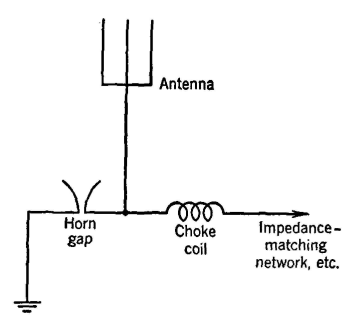| Electrical Communication is a free textbook on the basics of communication technology. See the editorial for more information.... |

|

Home  Interference and Noise Interference and Noise  Protection of Radio Equipment Protection of Radio Equipment |
|||






|
|||
Protection of Radio EquipmentRadio transmitters, which are powered from 60-cycle sources, are fused much as any electrical equipment. Radio receivers are seldom protected in any way. If a receiver has an antenna in an exposed location, such as above the roof, and if lightning is prevalent, it is advisable to use a suitable lightning arrester between the antenna lead-in wire and ground. These arresters are usually small gaps that arc over to ground if the voltage exceeds a certain safe value. Generally the arrester is placed outside the building and should have a direct connection to a good ground, such as a water pipe. Also, the ground wire and lead-in should be of reasonably large wire.
Radio transmitting antennas are usually quite tall, are located in exposed positions; and offer excellent targets for lightning discharges. The exact nature of the protection depends on the type of antenna, type of matching network, and whether it is a series-fed antenna45 with an insulated base or a shunt-fed antenna45 with a grounded base.62 The lightning protection is often a horn gap connected across the base insulator. A lightning discharge will flash across the horn gap, carrying the discharge to ground. This will put a short circuit on the feeder from the transmitter, and a power arc may follow, the energy for the power arc being supplied by the transmitter. The heat evolved will cause the arc to rise in the horn gap, quickly rupturing the arc, thus clearing the circuit.
|
|||
Home  Interference and Noise Interference and Noise  Protection of Radio Equipment Protection of Radio Equipment |
|||
Last Update: 2011-05-30


